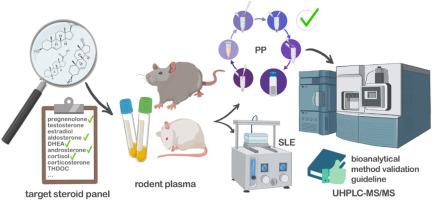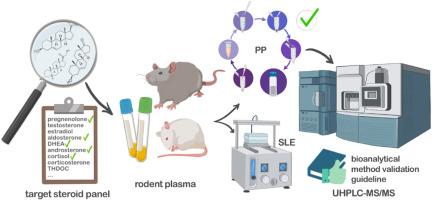Comprehensive targeted profiling of multiple steroid classes in rodent plasma using liquid chromatography-mass spectrometry
IF 5.7
2区 化学
Q1 CHEMISTRY, ANALYTICAL
引用次数: 0
Abstract
Background
Reliable quantification of multiple steroid classes in biological fluids within a single method remains an analytical challenge despite many previously published methods. Crosstalk of positional isomers, overlap of stereoisomer fragmentation patterns, differing proton affinities, in-source fragmentation, varying stability of protonated ions in the gas phase across steroid classes, and non-existence of steroid-free matrix are the main challenges limiting the number of simultaneously profiled steroids.
Results
In this study, we focused on the development of a derivatization-free, achiral, high-throughput, and cost-effective UHPLC-MS/MS approach that allows simultaneous profiling of a spectrum of 38 steroids covering progestogens, androgens, corticosteroids, and estrogens, while properly addressing the hurdles of steroid analysis. Within a 20-min method, 16 stereoisomers and 15 positional isomers were fully resolved within a single run while separated from 7 additional non-interfering steroids and matrix interferences in rodent plasma. Protein precipitation (PP) and supported liquid extraction (SLE) methods using only 40 μL of sample were developed to achieve the lowest possible limits of quantification. Nevertheless, 5α-dihydroprogesterone and 3α,5α-THDOC could be only qualitatively assessed when using PP. In contrast, DHEA-S could not be quantified or identified when using SLE. A novel surrogate matrix-background subtraction approach, using rat plasma after the animal's adrenalectomy, has been implemented into the optimized PP-UHPLC-MS/MS workflow, successfully validated according to the unified ICH/EMA M10 guidelines, and compared to the traditional quantification strategies. Moreover, the validity of the newly adopted approach has been verified by the targeted profiling of multiple biologically active endogenous steroids in more than 500 samples of mouse plasma in total.
Significance
Underestimation of hurdles associated with steroid analysis often compromises the accurate steroid quantification. Our comprehensive, fully validated UHPLC-MS/MS method targeting a wide spectrum of endogenous steroids, mitigating steroid crosstalk and using a minimal sample volume together with a novel surrogate matrix-background subtraction approach significantly advances steroid analysis for research and clinical applications covering multiple biological scopes.


利用液相色谱-质谱法对啮齿动物血浆中的多种类固醇进行全面的靶向分析
背景尽管以前发表过许多方法,但用一种方法对生物液体中的多种类固醇进行可靠的定量仍然是一项分析挑战。位置异构体的串扰、立体异构体碎片模式的重叠、质子亲和力的不同、源内碎片、不同类固醇在气相中质子化离子的稳定性不同以及不存在不含类固醇的基质是限制同时分析类固醇数量的主要挑战。结果在这项研究中,我们重点开发了一种无衍生化、非手性、高通量、高性价比的超高效液相色谱-质谱/质谱分析方法,该方法可同时分析 38 种类固醇,涵盖孕激素、雄激素、皮质类固醇和雌激素,同时还能妥善解决类固醇分析中遇到的障碍。在 20 分钟的方法中,一次运行即可完全解析 16 种立体异构体和 15 种位置异构体,同时与啮齿类动物血浆中另外 7 种非干扰类固醇和基质干扰分离。为了达到尽可能低的定量限,我们开发了仅使用 40 μL 样品的蛋白质沉淀和辅助液体萃取方法。然而,使用蛋白沉淀法只能定性评估 5α-二氢孕酮和 3α,5α-THDOC。与此相反,使用 SLE 时无法定量或识别 DHEA-S。在优化的PP-UHPLC-MS/MS工作流程中采用了一种新颖的替代基质-背景减去方法,该方法使用的是动物肾上腺切除术后的大鼠血浆,根据统一的ICH/EMA M10指南成功地进行了验证,并与传统的定量策略进行了比较。此外,在总共 500 多份小鼠血浆样本中对多种具有生物活性的内源性类固醇进行了有针对性的分析,从而验证了新方法的有效性。我们的超高效液相色谱-质谱/质谱(UHPLC-MS/MS)方法针对多种内源性类固醇,减轻了类固醇的串扰,样品量极少,并采用了新颖的替代基质-背景减去方法,极大地推动了类固醇分析在多种生物学领域的研究和临床应用。
本文章由计算机程序翻译,如有差异,请以英文原文为准。
求助全文
约1分钟内获得全文
求助全文
来源期刊

Analytica Chimica Acta
化学-分析化学
CiteScore
10.40
自引率
6.50%
发文量
1081
审稿时长
38 days
期刊介绍:
Analytica Chimica Acta has an open access mirror journal Analytica Chimica Acta: X, sharing the same aims and scope, editorial team, submission system and rigorous peer review.
Analytica Chimica Acta provides a forum for the rapid publication of original research, and critical, comprehensive reviews dealing with all aspects of fundamental and applied modern analytical chemistry. The journal welcomes the submission of research papers which report studies concerning the development of new and significant analytical methodologies. In determining the suitability of submitted articles for publication, particular scrutiny will be placed on the degree of novelty and impact of the research and the extent to which it adds to the existing body of knowledge in analytical chemistry.
 求助内容:
求助内容: 应助结果提醒方式:
应助结果提醒方式:


